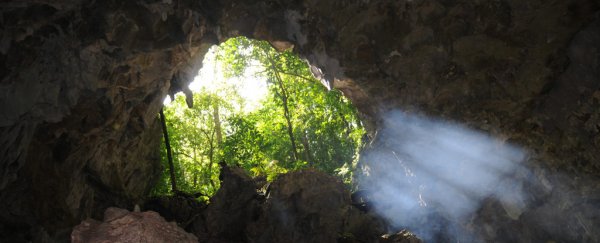You may not give a pile of bat poop gathered over 4,300 years a second look – but to a group of scientists, it's provided an intriguing insight into how bat diets and therefore climate conditions have shifted over thousands of years.
Taller than the average man (2 meters or 6-and-a-half feet), the pile of poop (also known as guano) records history in clear layers, much like sediments under a lake.
By analyzing the layers back through time, the scientists have been able to figure out changes in the diets of the bats that have been inhabiting this cave for millennia.
In turn, the dietary changes provide hints about what the climate and environment might have been like over that time, with variations in temperature and precipitation affecting animal life and the sorts of insects and plants that were available for bats to eat.
"We study natural archives and reconstruct natural histories, mostly from lake sediments," says limnologist Jules Blais, from the University of Ottawa in Canada. "This is the first time scientists have interpreted past bat diets, to our knowledge."
 Thin slices of bat guano core. (Chris Grooms)
Thin slices of bat guano core. (Chris Grooms)
The researchers were particularly interested in sterols, biochemical markers of diet produced by plant and animal cells. These sterols pass through the digestive system and can be preserved for thousands of years – as was the case here.
An analysis was also done of poop from the bats currently living in the same location: the Home Away from Home Cave in Jamaica, which at the moment is home to around 5,000 bats from five different species. That gave the team a baseline to work against.
There was a spike in plant sterols in the bats' diet around a thousand years ago, the researchers found – corresponding with the Medieval Warm Period (900-1,300 CE), when it's thought the Americas were particularly dry.
Another plant sterol spike was found from around 1,350 BCE, at a time known as the Minoan Warm Period. Drier conditions typically make life more difficult for insects, and during these times the bats were snacking more often on fruits.
"We inferred from our results that past climate has had an effect on the bats," says biologist Lauren Gallant, from the University of Ottawa. "Given the current changes in climate, we expect to see changes in how bats interact with the environment. That could have consequences for ecosystems."
Another interesting discovery was changes in the carbon composition of the guano, which probably correlates with the arrival of sugarcane in Jamaica in the 15th century. Chemical signatures of human activities like nuclear testing and the arrival of leaded gas could also be observed.
Bats are more important to ecosystems than you might have realized: they control insect populations, pollinate flowers, and disperse seeds. This cave method is a non-invasive, effective way of studying their diets and checking in on their wellbeing across a history that - with the right guano pile - can stretch to thousands of years.
It's also worth noting that the same techniques used here can be applied to other caves all around the world, the researchers say – which might be especially useful in areas without lakes and underlying sediments, which reveal a lot of the same information about the climate over time.
"As a piece of work showing what you can do with poo, this study breaks new ground," says geologist Michael Bird, from James Cook University in Australia, who wasn't involved in the new study.
"They really extended the toolkit that can be used on guano deposits around the world."
The research has been published in the Journal of Geophysical Research: Biogeosciences.
